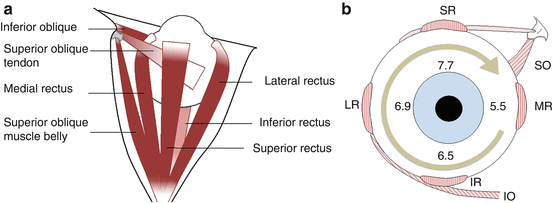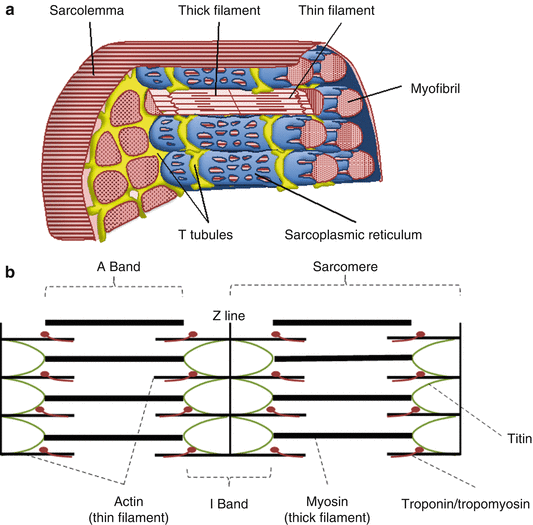(1)
University of Sydney, Sydney, Australia
Overview
Four rectus (superior, inferior, medial, and lateral) and two oblique (superior and inferior) extraocular muscles (EOMs) insert onto the eye and contribute to all ocular movements [1, 2].
The EOMs produce eye movements over a range of amplitudes and velocities, including:
(a)
Slow changes in eye position to track or stabilize visual targets
(b)
Fine-tuned micromovements
Anatomy (Fig. 16.1)
1.
Four rectus muscles
From here they travel anteriorly through the orbit forming a muscle cone.
The mean positions of the tendinous insertions are described by the spiral of Tillaux (Fig. 16.1b) [9]; however, interindividual variation of up to 4 mm has been observed [10].
Motor nerves penetrate the muscles posteriorly from within the cone [11].
2.
The superior oblique
The superior oblique (SO) arises from the posterior orbital wall superomedial to the apex [5].
It travels superiorly along the medial orbital wall to reach the trochlea, where it is redirected posteriorly, inferiorly, and toward the globe [13].
It passes beneath the superior rectus, crosses the equator, and inserts onto the posterolateral globe [14].
3.
The inferior oblique
The inferior oblique (IO) arises in the nasal bony orbit and passes inferior to the inferior rectus [5].
Its path mirrors the superior oblique tendon and inserts onto the posterolateral inferior globe.
4.
The levator palpebrae superioris (see Chap. 1. Protective Mechanisms of the Eye and Eyelids)
The levator palpebrae superioris arises at the orbital apex superior to the annulus of Zinn.
It continues anteriorly through the superior orbit and becomes an aponeurosis, inserting onto the upper lid skin crease and superior tarsal plate.
6.
Geometric anatomy of the orbit, eye, and extraocular muscles [1, 5]
The orbit forms a pyramid; the lateral and medial walls are 45° to one another.
The central axis of the orbit is at a 23° lateral deviation to midline (Fig. 16.3a).

Fig. 16.3
(a) The geometric anatomy of the orbit. (b) The angles of insertion of the recti and oblique muscles in primary gaze
In the primary gaze position (both eyes facing forward):
(a)
The superior rectus (SR) and inferior rectus (IR) form an angle of 23° with the visual axis.
7.
Orbital connective tissue septae
A complex framework of orbital connective tissue septae exists.
This consists of a smooth muscle and connective tissue network containing nerves and vessels [20].
These constrain and stabilize the EOMs, controlling the direction of force during muscle contraction and allowing predictable globe movements [21].
General Characteristics of the Extraocular Muscles
EOMs are skeletal muscles; their fibers resemble other skeletal muscle fibers in the following ways:
1.
2.
Myofibril structure
3.
Electrical control of contraction
On neural stimulation, a depolarizing membrane potential travels along the sarcolemma.
The depolarizing potential enters the muscle fiber via an invaginating T-tubule system [25].
The T-tubules terminate near the sarcoplasmic reticulum (SR), an intracellular calcium (Ca2+) storage system.
Depolarizing signal from the T-tubules results in release of intracellular Ca 2+ from the SR.
4.
Molecular basis of contraction
Contraction occurs by ATP-dependent binding of actin to myosin.
Myosin slides over actin filaments via sequentially formed and broken covalent bonds [26].
Troponin and tropomyosin are regulatory proteins that prevent actin-myosin interaction at rest.
Special Characteristics of the Extraocular Muscles
The EOMs have unique characteristics distinctive from other skeletal muscles:
1.
Layered organization
(i)
The global layer
The global layer extends the full muscle length and continues anteriorly as the muscle tendon.
It inserts onto the sclera to directly control globe movements [30]
2.
Fiber types:
(i)
Typical skeletal muscle fiber classification
Most skeletal muscle fibers are broadly categorized into red, white, or intermediate determined by:
(a)
Blood supply
(b)
Concentration of myoglobin, an oxygen-binding red pigment
Red fibers predominantly use aerobic metabolism for slow, tonic, fatigue-resistant contractions.
White fibers use anaerobic glycolysis for rapid twitches and fatigue quickly.
(ii)
EOM fiber classification (Table 16.1) [31–37]
Orbital layer | Global layer | |||||
|---|---|---|---|---|---|---|
Fiber type | Singly innervated | Multiply innervated | Red singly innervated | White singly innervated | Intermediate singly innervated | Multiply innervated |
% Fibers within the layer | 80 | 20 | 33 | 32 | 25 | 10 |
Contraction mode | Twitch | Mixed | Twitch | Twitch | Twitch | Non-twitch |
Contraction speed | Fast | Fast and slow | Fast | Fast | Fast | Slow |
Fatigue resistance | High | Variable | High | Low | Intermediate | High |
EOM fibers are subclassified into 6 distinct fiber types characterized by:
(a)
Layer
(b)
Innervation type (singly or multiply)
(c)
Color (myoglobin content)
All fiber types participate in all classes of eye movements [1].
3.
Myosin isoforms:
(i)
Typical skeletal muscle myosin isoforms
4.
Innervation pattern:
Get Clinical Tree app for offline access

(i)
Typical skeletal muscle innervation
(ii)
Extraocular muscle fiber innervation
EOM fibers can be broadly divided into singly- and multiply-innervated fibers.
(iii)
Singly-innervated extraocular muscle fibers
Like other skeletal muscle fibers, singly-innervated EOM fibers are innervated by one motor axon.
However, they have unique motor end plates that are smaller and more simple than those found in typical skeletal muscle [49].
(iv)
Multiply-innervated fibers
Multiply-innervated fibers are unique to EOMs.
Their motor neurons are functionally distinct from those innervating singly-innervated fibers [50, 51].
The fibers have small, multiple grape-like nerve terminals mostly clustered at the fiber ends [52, 53].

Stay updated, free articles. Join our Telegram channel

Full access? Get Clinical Tree





